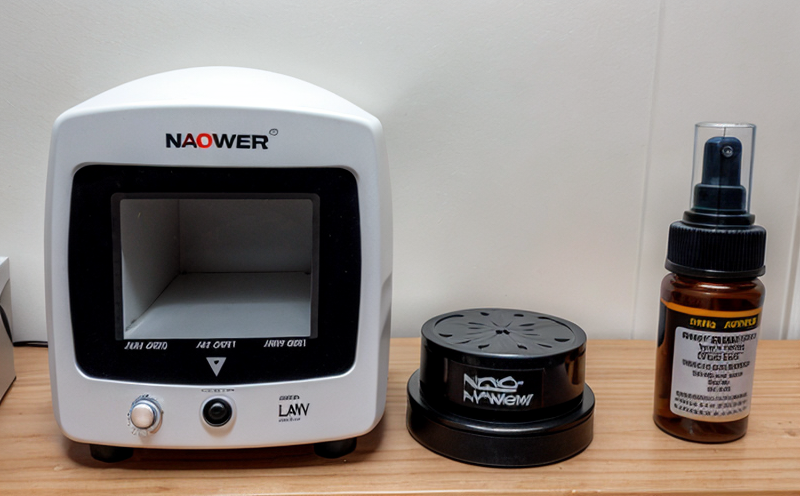OECD TG 403 Acute Inhalation Toxicity Testing of Nanoparticles
The OECD Test Guideline 403 (TG 403) for the acute inhalation toxicity testing of nanoparticles is a critical tool in ensuring that nanomaterials are safe and environmentally responsible. This guideline provides standardized procedures to evaluate the potential respiratory hazards associated with the exposure to engineered nanoparticles, which can have vastly different physical properties compared to bulk materials.
The test is designed for both inhalation toxicity assessment and local effects evaluation following acute exposure of experimental animals. The focus is on determining the lethal dose (LD50) or median lethal concentration (LC50), as well as any observed adverse effects that may occur at lower doses. This information is crucial for regulatory purposes, product development, and ensuring compliance with international standards.
The OECD TG 403 protocol specifies a robust set of parameters to ensure accurate and reproducible results. It mandates the use of specific animal species, exposure chambers, and dose delivery systems that are optimized for nanoparticle deposition in the respiratory tract. The test requires careful preparation of nanoparticles according to standard procedures, ensuring uniformity in particle size, shape, and surface characteristics.
The protocol also emphasizes the importance of controlled environmental conditions during testing, including temperature, humidity, and airflow within the exposure chamber. This ensures that any observed effects are attributable to the nanoparticle itself rather than external factors. Post-exposure monitoring involves detailed observations of animal health and behavior, as well as pathological examinations if necessary.
Given the unique properties of nanoparticles, this testing method is particularly important for materials like carbon nanotubes, metal oxides, and other engineered particles that could pose significant risks to human health. By adhering strictly to the OECD TG 403 protocol, laboratories can provide reliable data that informs regulatory decisions and supports responsible innovation in nanotechnology.
The test results are reported comprehensively, detailing the dose-response relationship, observed effects, and any relevant statistical analyses. This information is essential for risk assessment and the development of appropriate safety measures. Regulatory bodies such as the European Chemicals Agency (ECHA) and the U.S. Environmental Protection Agency (EPA) rely on these data to set safe exposure limits.
| Standard | Description |
|---|---|
| OECD TG 403 | Acute Inhalation Toxicity Testing of Nanoparticles |
| ISO 17628-2 | Safety aspects related to engineered nanomaterials - Part 2: Exposure assessment and control |
The application of OECD TG 403 is not limited to just the pharmaceutical or consumer product industries. It plays a vital role in sectors such as electronics, energy storage, and environmental remediation where nanoparticles are used extensively. Ensuring that these materials do not pose undue risks to human health and the environment is paramount.
| Aspect | Description |
|---|---|
| Preliminary Studies | Determine the appropriate dose levels for the test and ensure that the exposure system is capable of delivering nanoparticles uniformly. |
| Exposure Conditions | Controlled environment with specific temperature, humidity, and airflow parameters to minimize variability in results. |
Applied Standards
The OECD TG 403 protocol is aligned with several international standards that provide additional guidance on the safe handling and testing of nanoparticles. These include:
- ISO 17628-2: This standard focuses on the safety aspects related to engineered nanomaterials, particularly in terms of exposure assessment and control measures.
- ASTM E2914: This American Society for Testing and Materials standard provides a framework for evaluating the cytotoxicity and genotoxicity of nanomaterials through in vitro testing methods.
Scope and Methodology
The scope of OECD TG 403 encompasses both the acute inhalation toxicity assessment and the evaluation of local effects following exposure to nanoparticles. The methodology involves several key steps:
- Preliminary Studies: Conduct preliminary studies to determine the appropriate dose levels for the test and ensure that the exposure system is capable of delivering nanoparticles uniformly.
- Exposure Conditions: Control the environmental conditions within the exposure chamber, including temperature, humidity, and airflow parameters, to minimize variability in results.
- Animal Selection: Use specific animal species that are known to be susceptible to respiratory challenges, ensuring a robust and reproducible test outcome.
- Exposure Procedure: Deliver the nanoparticles via inhalation into the exposure chamber under controlled conditions. Monitor the animals closely for signs of toxicity or adverse effects.
- Post-Exposure Monitoring: Conduct detailed observations and pathological examinations to assess any health impacts resulting from the exposure.





